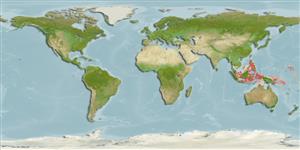Klassifizierung / Names
Namen | Synonyme | Catalog of Fishes(Gattung, Arten) | ITIS | CoL | WoRMS | Cloffa
>
Gobiiformes (Gobies) >
Gobiidae (Gobies) > Gobiinae
Etymology: Eviota: No etymology given, suggested by Christopher Scharpt: from Latin 'eu' for 'true' and 'iota' for anything very small, in combination 'truly very small' referring to it as being the smallest vertebrate at the time it has benn described by Jenkins (thus, making the suggestion by Scharpt plausible.; pictifacies: Name from Latin adjective 'pictus' or painted and the female noun 'facies' for face; referring to the bright red spots on the side of the head, similar to those painted on a clown; treated as a feminine compound adjective..
Environment: milieu / climate zone / depth range / distribution range
Ökologie
seewasser riff-verbunden; tiefenbereich 3 - 8 m (Ref. 115282). Tropical
Verbreitung
Länder | FAO Gebiete | Ecosystems | Vorkommen | Point map | Einführungen | Faunafri
Western Pacific: Indonesia.
Size / Gewicht / Alter
Maturity: Lm ? range ? - ? cm
Max length : 1.6 cm SL Männchen/unbestimmt; (Ref. 115282); 1.7 cm SL (female)
Kurzbeschreibung
Morphologie | Morphometrie
Rückenflossenstacheln (insgesamt): 7; Rückenflossenweichstrahlen (insgesamt): 9; Afterflossenstacheln 1; Afterflossenweichstrahlen: 8. This species is distinguished by the following characters: cephalic sensory-canal pore system complete (pattern 1), with the PITO pore very small; dorsal/anal fin-ray formula 9/8; some of pectoral-fin rays are branched; 5th pelvic-fin ray present; presence of a distinct dark occipital spot (intense in preservative, but visible in life); no series of small dark spots along dorsal-fin bases; 2 separate orange spots behind the eye; distinctive black marks on the underside of the head; side of head with large round red spots; scleral surface of eye with bold dark-brown-and-white markings (Ref. 115282).
This species occurs in shallow fringing reef which is subject to significant terrigenous sedimentation and relatively warm water due to the limited circulation in the large bay of Teluk Saleh. Often found resting on live massive coral colonies (Ref. 115282).
Life cycle and mating behavior
Geschlechtsreife | Fortpflanzung | Ablaichen | Eier | Fecundity | Larven
Greenfield, D.W. and M.V. Erdmann, 2017. Eviota pictifacies, a new dwarfgoby from Sumbawa, Indonesia (Teleostei: Gobiidae). J. Ocean Sci. Found. 27:1-7. (Ref. 115282)
IUCN Rote Liste Status (Ref. 130435)
Bedrohung für Menschen
Harmless
Nutzung durch Menschen
Mehr Information
LänderFAO GebieteEcosystemsVorkommenEinführungenStocksÖkologieNahrungNahrungsorganismenNahrungsaufnahmeNahrungsmenge
NamenSynonymeMetabolismusRäuberÖkotoxikologieFortpflanzungGeschlechtsreifeAblaichenSpawning aggregationFecundityEierEientwicklung
Alter/GrößeWachstumLänge-GewichtLänge-LängeLängenhäufigkeitenMorphometrieMorphologieLarvenLarven Pop.Dyn.RekrutierungDichteBRUVS
ReferenzenAquakulturAquakultur ProfilZuchtlinienGenetikElectrophoresesVererbbarkeitKrankheitenVerarbeitungNutrientsMass conversion
PartnerBilderStamps, Coins Misc.LauteCiguateraGeschwindigkeitSchwimmstilKiemenoberflächeOtolithsGehirngrößeSehfähigkeit
Tools
Zusatzinformationen
Download XML
Internet Quellen
Estimates based on models
Phylogenetic diversity index (Ref.
82804): PD
50 = 0.5000 [Uniqueness, from 0.5 = low to 2.0 = high].
Bayesian length-weight: a=0.00708 (0.00333 - 0.01504), b=3.09 (2.92 - 3.26), in cm total length, based on LWR estimates for this (Sub)family-body shape (Ref.
93245).
Trophic level (Ref.
69278): 3.0 ±0.3 se; based on size and trophs of closest relatives
Widerstandsfähigkeit (Ref.
120179): hoch, Verdopplung der Population dauert weniger als 15 Monate. (Preliminary K or Fecundity.).
Fishing Vulnerability (Ref.
59153): Low vulnerability (10 of 100).
